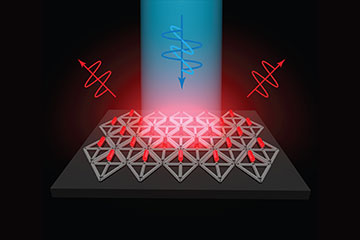
Engineers at the Massachusetts Institute of Technology, USA, have used DNA origami scaffolds to create precisely structured arrays of quantum rods, which could be incorporated into LEDs for televisions or virtual reality devices. [Image: Xin Luo, BatheBioNanoLab]
Researchers at the Massachusetts Institute of Technology (MIT), USA, have developed a faster way to create 2D arrays of quantum rods using DNA origami technology (Sci. Adv., doi: 10.1126/sciadv.adh8508). They say that the method, which reduces manufacturing time from a few days to a few minutes, could have applications for micro-LEDs and next-generation displays.
Leveraging DNA
Commercially available QLED displays add a quantum dot layer to a traditional LED backlight to enhance both color and contrast. Layers of quantum rods, which boast polarized light emission, would have the ability to generate 3D images for virtual reality devices and improve optical efficiency for displays in general.
However, high-quality polarized light sources would require the alignment of quantum rods along their long axes at the nano- to microscale, which is challenging to produce reliably. Mark Bathe and his colleagues employed DNA origami—the folding of DNA to create 2D and 3D objects at the nanoscale—in a new process that deposits quantum rods onto a DNA scaffold in a highly controlled way. It can be applied to both quantum dots and quantum rods of various sizes, aspect ratios, spectra and shell surfaces.
“DNA is particularly attractive as a manufacturing material because it can be biologically produced, which is both scalable and sustainable.” —Mark Bathe
“DNA is particularly attractive as a manufacturing material because it can be biologically produced, which is both scalable and sustainable, in line with the emerging US bioeconomy,” said study author Bathe, professor of biological engineering at MIT, in a press release accompanying the research.
Nanoscale precision
The approach involves emulsifying DNA into a mixture with quantum rods, then rapidly dehydrating the mixture. The dehydration allows the DNA molecules to form a dense layer on the surface of the rods. This superfast process substantially shortens manufacturing time from several days to just a few minutes.
The researchers then sought to fabricate arrays of these densely DNA-functionalized quantum rods with wireframe origami templates. They developed a method, surface-assisted large-scale assembly (SALSA), to construct 2D origami lattices directly on a solid substrate. This allowed the researchers to template scalable 2D arrays of quantum rods with nanoscale spatial and orientational precision.
“The quantum rods sit on the origami in the same direction, so now you have patterned all these quantum rods through self-assembly on 2D surfaces, and you can do that over the micron scale needed for different applications like micro-LEDs,” said Bathe. “You can orient them in specific directions that are controllable and keep them well separated because the origamis are packed and naturally fit together, as puzzle pieces would.”
Next steps
“The next steps are going to be making arrays that are more hierarchical, with programmed structure at many different length scales.” —Robert Macfarlane
Bathe and his colleagues hope that the combination of dehydration-assisted DNA conjugation and SALSA will help facilitate the translation of nanoscale DNA origami design strategies into surface nanofabrication.
“The next steps are going to be making arrays that are more hierarchical, with programmed structure at many different length scales,” said Robert Macfarlane, associate professor of materials science and engineering at MIT. “The ability to control the sizes, shapes and placement of these quantum rod arrays is a gateway to all sorts of different electronics applications.”
